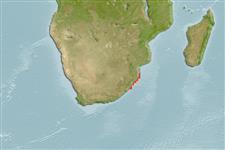Classification / Names
ชื่อสามัญ | ชื่อพ้อง | Catalog of Fishes(สกุล, ชนิด) | ITIS | CoL | WoRMS | Cloffa
>
Pleuronectiformes (Flatfishes) >
Soleidae (Soles)
Etymology: Aseraggodes: Greek, aggos, -eos, -ous = vessel, uterus, carapace of a crab + Greek, aseros, -a, -on = to remove the appetite (Ref. 45335); heemstrai: Named for Phillip Heemstra..
More on authors: Randall & Gon.
Environment: milieu / climate zone / depth range / distribution range
นิเวศวิทยา
เกี่ยวกับทะเล,น้ำเค็ม เกี่ยวกับหินโสโครก; ระดับความลึก 15 - 39 m (Ref. 57561). Tropical; 27°S - 31°S (Ref. 57561)
Western Indian Ocean: South Africa.
ขนาด / น้ำหนัก / Age
Maturity: Lm ? range ? - ? cm
Max length : 8.7 cm SL เพศผู้/กระเทย; (Ref. 57561)
Short description
สัณฐานวิทยา | ความยาวต่างๆ
ก้านครีบอ่อนที่หาง (รวม): 68-75; ก้านครีบอ่อนที่ก้น: 48 - 52; สัตว์มีกระดูกสันหลัง: 36 - 38. DIAGNOSIS: Dorsal rays 68-75; anal rays 48-52; dorsal and anal rays branched except for a few anterior rays; lateral-line scales 70-78, including 9 or 10 anterior to a vertical at upper
end of gill opening; lateral line on ocular side projecting toward dorsal part of upper
eye; vertebrae 36-38; dorsal pterygiophores anterior to fourth neural spine 11-13; body
depth 2.4-2.45 in SL; head length (HL) 4.05-4.35 in SL; snout length 2.65-2.95 in HL; eye diameter 4.6-5.05 in HL; interorbital space very narrow, the least vertical width 26-33 in HL; tubular anterior nostril nearly reaching eyeball when laid back; cirri on front of snout and ventral side of head small and slender; no cirri on opercle at edge of gill opening, and none along edge of membranous ridges of dorsal and anal rays; caudal peduncle present but very short, the length 10.2-17.7 in HL; caudal-peduncle depth 1.7-1.95 in HL; longest dorsal ray 1.65-1.8
in HL; caudal-fin length 4.2-4.7 in SL; pelvic-fin length 1.75-2.0 in HL, reaching base third anal ray; color of ocular side when fresh brown, the edges of scales darker brown, with numerous irregular dark-edged white spots, the largest (most smaller than eye) in three rows, one below dorsal .n, one above anal .n, and one along lateral line, where most irregular; scattered small blackish spots, some specimens with indistinct larger blackish blotches alternating with large white spots of the three rows; fin rays with small brown and larger white spots, the membranes translucent. Color in alcohol with white spots, faint to absent and dark spots subdued (Ref. 57561).
Life cycle and mating behavior
วัยเจริญพันธุ์ | การสืบพันธุ์ | การวางไข่ | เซลสืบพันธ์ของเพศเมีย(ไข่) | ความดกของไข่ | ตัวอ่อน
Randall, J.E. and O. Gon, 2006. Review of the soles of the genus Aseraggodes of the Western Indian Ocean, with descrtiptions of three new species. Israel J. Zool. 51:165-190. (Ref. 57561)
IUCN Red List Status (Ref. 130435)
Threat to humans
Harmless
Human uses
ข้อมูลเพิ่มเติม
ชื่อสามัญชื่อพ้องกลไกการเผาผลาญพลังงานผู้ล่าการศึกษาเกี่ยวกับผลกระทบของสารประกอบทางเคมีที่เป็นอันตรายต่อสิ่งมีชีวิต ประชากร และสิ่งแวดล้อมการสืบพันธุ์วัยเจริญพันธุ์การวางไข่การรวมกลุ่มวางไข่ความดกของไข่เซลสืบพันธ์ของเพศเมีย(ไข่)Egg development
Age/SizeการเจริญเติบโตLength-weightLength-lengthLength-frequenciesความยาวต่างๆสัณฐานวิทยาตัวอ่อนพลวัตของสัตว์น้ำวัยอ่อนการทดแทนที่อุดมสมบรูณ์BRUVS
อ้างอิงการเพาะเลี้ยงสัตว์น้ำประวัติการเพาะเลี้ยงสัตว์น้ำสายพันธุ์พันธุศาสตร์ElectrophoresesอัตราพันธุกรรมโรคการแปรรูปNutrientsMass conversion
ผู้ร่วมมือรูปภาพหลายรูปStamps, Coins Misc.เสียงปลามีพิษ เช่น ปลาปักเป้าความเร็วรูปแบบการว่ายน้ำพื้นที่เหงือกOtolithsสมองวิสัยทัศน์
เครื่องมือ
Special reports
Download XML
แหล่งที่มาจากอินเตอร์เน็ต
Estimates based on models
Preferred temperature (Ref.
123201): 22.5 - 24.3, mean 23.9 °C (based on 8 cells).
Phylogenetic diversity index (Ref.
82804): PD
50 = 0.5000 [Uniqueness, from 0.5 = low to 2.0 = high].
Bayesian length-weight: a=0.00977 (0.00473 - 0.02021), b=3.07 (2.90 - 3.24), in cm total length, based on LWR estimates for this (Sub)family-body shape (Ref.
93245).
ระดับชั้นอาหาร (Ref.
69278): 3.5 ±0.5 se; based on size and trophs of closest relatives
ความสามารถในการกลับคืนสู่ปกติ (Ref.
120179): ความสูง, เวลาต่ำสุดที่จะทำให้ประชากรเพิ่มขึ้นเป็น 2 เท่าใช้เวลาน้อยกว่า 15 เดือน (Preliminary K or Fecundity.).
Fishing Vulnerability (Ref.
59153): Low vulnerability (10 of 100).
